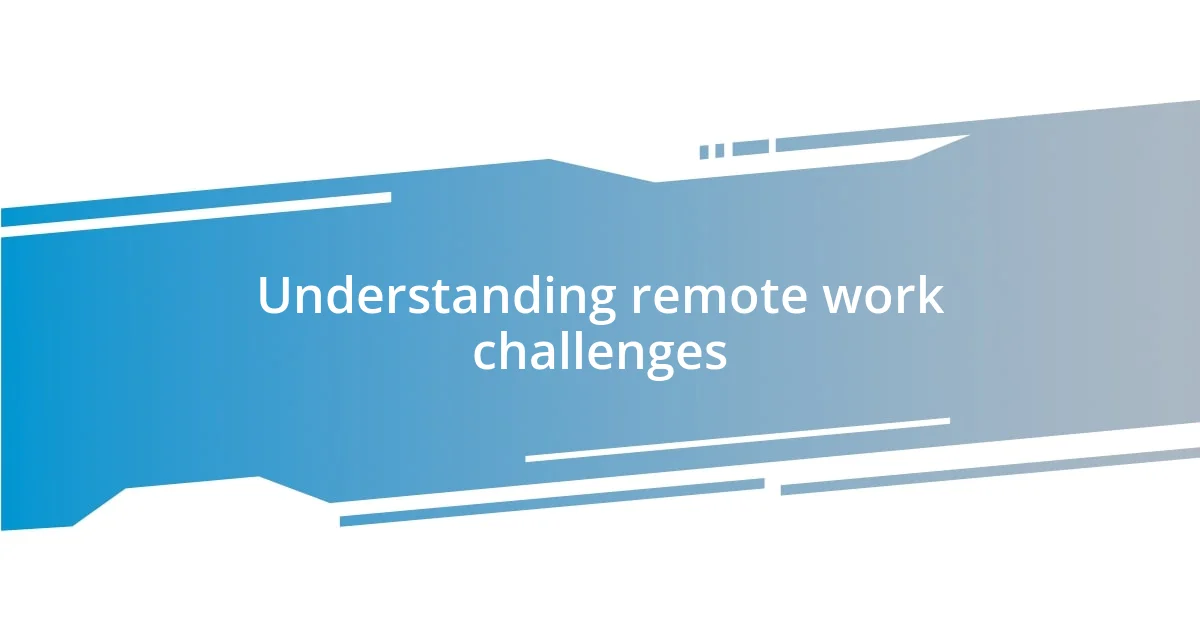Key takeaways:
- Isolation and lack of spontaneous interaction were significant challenges in transitioning to remote work, necessitating the establishment of clear boundaries and communication strategies.
- Creating a dedicated home office setup, complete with ergonomic furniture and proper lighting, dramatically improved productivity and mental separation between work and personal life.
- Building a supportive virtual community through regular check-ins, celebrating small wins, and fostering informal interactions strengthened team bonds and enhanced overall morale.

Understanding remote work challenges
One of the most significant challenges I encountered while adjusting to remote work was the struggle with isolation. As someone who thrived in a collaborative office environment, I found it disheartening to miss spontaneous conversations and the collective energy of a team. Have you ever felt that sudden emptiness when you realize you’re working in silence? It’s a peculiar feeling, almost as if the creative sparks are dulled without the chatter of colleagues around.
Time management also became a tricky beast to tame. I vividly remember those early weeks, where my schedule morphed into a free-for-all. How often have you sat down with the best intentions only to find hours slipping by while distractions swirl around? For me, it was the siren call of laundry, snacking, and even my comfy couch. Eventually, I learned to draw lines between work and home life, establishing a routine that truly helped me stay focused.
Another layer to this remote work challenge is the pressure to always be ‘on.’ I felt this invisible weight pushing me to respond immediately to messages and keep my video camera on at all times. Can you relate? There’s an unspoken expectation that’s hard to shake off when the office is now just a few steps away. Balancing productivity with mental health became vital, and addressing that imbalance has opened my eyes to the importance of setting boundaries in this new work culture.

Developing a home office setup
Creating a home office setup was a transformative experience for me. Initially, I worked at my dining table, which felt like a temporary solution at best. I quickly realized that I needed a dedicated workspace to carve out that mental separation between my work and personal life. Every time I would grab a snack from the kitchen, I found myself doomscrolling through social media instead of focusing on my tasks. Designating a specific area for work made a huge difference in my productivity and mindset.
Here are a few essentials I found beneficial for my home office:
- Ergonomic chair: Investing in a comfortable chair helped alleviate discomfort during long hours of sitting.
- Good lighting: Soft, natural light from a window did wonders; I’ve swapped out harsh overhead lights for a desk lamp with a warm glow.
- Dual monitors: I can’t stress enough how a second screen increased my efficiency. It makes multitasking feel effortless.
- Noise-canceling headphones: These became my sanctuary whenever family was home, letting me immerse myself in work without distractions.
- Cable management: Keeping cords tidy not only helped the aesthetics but also minimized the irritation of tangled cables while working.
Establishing this space allowed me to channel my energy more effectively. I remember the first day I worked from my new desk with a plant beside me, feeling a sense of calm wash over me—just like I had transported a piece of the office to my home. It was a small but significant victory that made every workday much more enjoyable.

Managing work-life balance effectively
Managing a healthy work-life balance while working remotely can be quite the challenge. For me, it took a bit of trial and error to find what genuinely worked. I realized early on that without clear boundaries, my work could easily seep into personal time. I recall one evening, after a long day of meetings, I found myself answering emails while cooking dinner. That was my wake-up call to establish strict cut-off times for work. Balancing those hours taught me the value of a structured schedule—not just for productivity, but for my overall well-being.
Making time for breaks played a crucial role as well. In those first few weeks, I would often overlook the importance of stepping away from my screen. I once pushed through a deadline, only to find myself staring at a blank page, utterly drained. On a weekend trip, I tried incorporating short walks during my workday, and it revitalized my focus immensely. I learned that taking those brief moments for myself not only lifted my spirits but also improved my productivity when I returned to my tasks. Have you ever noticed how fresh air can spark creativity?
Lastly, communication with my family helped to reinforce the balance between work and home. I distinctly remember a day when my toddler barged into my workspace during a video call. It was a funny chaos, but it prompted a family discussion about respecting work hours. By setting mutual expectations, we created a harmonious environment that allows for both productivity and family time. This gave me a sense of shared space and understanding, which was a game changer in how I viewed work-life balance.
| Challenge | Solution |
|---|---|
| Blurred boundaries | Set strict work hours |
| Lack of breaks | Incorporate short breaks throughout the day |
| Family distractions | Communicate work expectations with family |

Staying connected with colleagues
Staying connected with colleagues in a remote work environment required some creative thinking on my part. I vividly remember our first virtual happy hour; it felt a bit awkward at first, but as the conversation flowed, I realized how much I missed those casual chats by the water cooler. I started exploring various platforms for video calls and even casual online games, like virtual trivia, to keep the camaraderie alive. Isn’t it interesting how something as simple as a shared laugh over a game can instantly bridge the gap created by distance?
In my experience, regular check-ins became vital, not just for project updates but also to gauge how everyone was feeling. I recall one meeting in particular when a colleague shared their struggles with isolation. It struck a chord with me, and I initiated a support chat group where we could share our challenges and victories. This simple act of reaching out fostered a sense of community that was incredibly uplifting. Have you ever found that a little vulnerability can lead to deeper connections with others?
As time went on, I discovered the power of celebrating small wins together. Instituting “Win Wednesdays” allowed us to share achievements—whether it was completing a project or finally mastering a new skill. I loved seeing the spirits rise as we cheered each other on, making the remote setting feel less lonely. It reinforced the idea that, even though we’re miles apart, we’re part of a team that values and supports each other. This connection transformed my work experience into something genuinely rewarding.

Enhancing productivity in isolation
Finding ways to enhance productivity while isolated can be a bit of a puzzle for many of us. I remember a time when I decided to redecorate my workspace; it was a small shift, but it drastically improved my mood and focus. Surrounding myself with inspiring quotes and plants not only made my workspace feel cozy but also sparked my creativity. Have you ever thought about how your environment can impact your productivity?
In hindsight, I realized that starting my day with a well-defined routine was a game changer. For instance, I began mapping out my tasks each morning while sipping my coffee, which provided me with clarity and purpose. This simple act of planning helped me prioritize my most important tasks and kept me on track. On some days, if I felt a lack of motivation creeping in, I would switch up my playlist—music has a remarkable way of elevating energy levels and diving back into work.
Moreover, I found that setting small, achievable goals throughout the day helped maintain high energy levels. One afternoon, I decided to tackle a daunting project by breaking it down into bite-sized tasks. I was amazed at how much easier it felt to push through when I celebrated each completed item. Similar to how athletes focus on their next play rather than the entire game, focusing on immediate milestones can drive productivity. Isn’t it empowering to witness your progress, even in small increments?

Adapting communication strategies
Adapting my communication strategies was essential to bridge the gap of remote work dynamics. Early on, I realized that email wasn’t enough to convey tone and emotion. I vividly recall a moment when I mistakenly interpreted a colleague’s message as overly critical. To avoid such misunderstandings, I began incorporating more voice notes and video messages, instantly infusing personality into our communications. Have you ever noticed how much easier it is to connect when you can hear someone’s enthusiasm or concern?
I also embraced the idea of “over-communicating” in certain situations. Initially, it felt unnecessary, but I found that clarifying expectations and providing regular updates helped everyone stay aligned and engaged. For example, during a particularly complex project, I held brief daily stand-ups, allowing us to air concerns and celebrate progress. It acted like a group hug—expanding our virtual connections while reinforcing accountability. Isn’t it fascinating how a few extra words can transform isolation into collaboration?
Establishing clear boundaries became another crucial aspect of my communication strategy. I remember feeling overwhelmed when colleagues would message me late at night, expecting immediate responses. So, I set specific hours for work-related communication, which not only protected my personal time but also helped colleagues understand when to reach out. This shift reduced stress and promoted healthier interactions. Have you thought about how defining boundaries could enhance not just your productivity but also your relationships?

Building a supportive virtual community
Building a supportive virtual community truly transformed my remote work experience. I distinctly remember the first virtual coffee chat I organized with my colleagues; the laughter and casual conversation revitalized our sense of camaraderie. It was more than just a break; it created an atmosphere where we could share personal stories and connect beyond work-related tasks. Have you ever felt that spark of connection during an unstructured chat?
In my journey, I came to appreciate the importance of celebrating small wins together, even in a virtual setting. I still reflect on the time when we launched a new project. We decided to host a virtual happy hour where each team member shared their achievements. To my surprise, hearing everyone’s success stories not only boosted morale but made us all feel valued as individuals. Don’t you think that recognizing collective milestones can significantly strengthen a team’s bond?
Moreover, I discovered that creating dedicated channels for interests outside of work, such as hobbies or pets, cultivated a sense of belonging. One day, a colleague shared a picture of their new puppy in our chat, and it sparked an enthusiastic exchange of pet photos. I felt a wave of warmth seeing how we could uplift one another by sharing snippets of our lives. Could it be that these small interactions are the glue that holds our virtual community together?
















